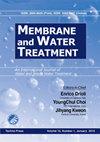纳滤反渗透膜分离电镀废水中试研究
IF 1.1
4区 工程技术
Q4 ENGINEERING, CHEMICAL
引用次数: 2
摘要
含有各种重金属的电镀废水可以由几个行业产生。具体而言,我们专注于从电镀废水中去除铜(Cu2+)和镍(Ni+)离子,因为在韩国,所有这些离子在排入流域时都受到严格监管。研究了纳滤(NF)和反渗透(RO)技术在含铜和镍离子废水处理中的应用,以减少淡水消耗和环境退化。在这项工作中,在使用两种商业纳滤(NF)和反渗透(RO)螺旋缠绕膜组件(东丽化学的NE2521-90和RE2521-FEN)之前,对合成水中铜(Cu2+)和镍(Ni+)离子的去除进行了中试规模的去除研究。考察了进料浓度等主要操作参数对两种膜的重金属截留率和渗透通量的影响。制备了含有不同浓度(1、20、100、400mg/L)的铜(Cu2+)和镍(Ni2+)离子的合成电镀废水样品,并在中试装置中进行了NF和RO处理。结果表明,NF、RO工艺对铜和镍的去除率分别为98%和99%,可获得较高的重金属去除率。本文章由计算机程序翻译,如有差异,请以英文原文为准。
Pilot scale membrane separation of plating wastewater by nanofiltration and reverse osmosis
Plating wastewater containing various heavy metals can be produced by several industries. Specifically, we focused on the removal of copper (Cu2+) and nickel (Ni+) ions from the plating wastewater because all these ions are strictly regulated when discharged into watershed in Korea. The application of both nanofiltration (NF) and reverse osmosis (RO) technologies for the treatment of wastewater containing copper and nickel ions to reduce fresh water consumption and environmental degradation was investigated. In this work, the removal of copper (Cu2+) and nickel (Ni+) ions from synthetic water was studied on pilot scale remove by before using two commercial nanofiltration (NF) and reverse osmosis(RO) spiral-wound membrane modules (NE2521-90 and RE2521-FEN by Toray Chemical). The influence of main operating parameters such as feed concentration on the heavy metals rejection and permeate flux of both membranes, was investigated. Synthetic plating wastewater samples containing copper (Cu2+) and nickel (Ni2+) ions at various concentrations(1, 20, 100, 400 mg/L) were prepared and subjected to treatment by NF and RO in the pilot plant. The results showed that NF, RO process, with 98% and 99% removal for copper and nickel, respectively, could achieve high removal efficiency of the heavy metals.
求助全文
通过发布文献求助,成功后即可免费获取论文全文。
去求助
来源期刊

Membrane Water Treatment
ENGINEERING, CHEMICAL-WATER RESOURCES
CiteScore
1.90
自引率
30.00%
发文量
0
审稿时长
>12 weeks
期刊介绍:
The Membrane and Water Treatment(MWT), An International Journal, aims at opening an access to the valuable source of technical information and providing an excellent publication channel for the global community of researchers in Membrane and Water Treatment related area. Specific emphasis of the journal may include but not limited to; the engineering and scientific aspects of understanding the basic mechanisms and applying membranes for water and waste water treatment, such as transport phenomena, surface characteristics, fouling, scaling, desalination, membrane bioreactors, water reuse, and system optimization.
 求助内容:
求助内容: 应助结果提醒方式:
应助结果提醒方式:


